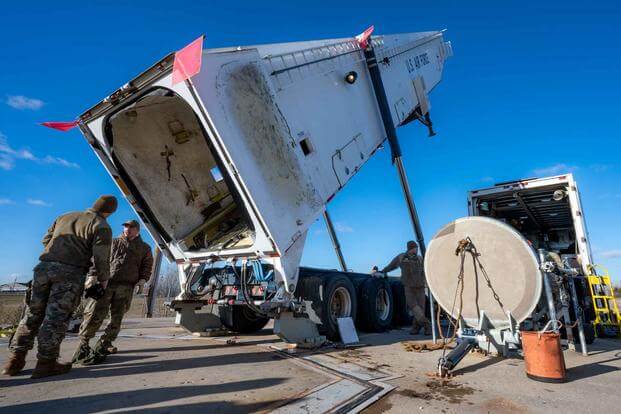
The Air Force said it is now examining whether 14 different cancers may be more prevalent among its active-duty and veteran missileers and expanding an ongoing study to see if service has put their health at increased risk.
Carcinogens that likely cause cancer — such as polychlorinated biphenyls, or PCBs — were detected and cleaned up at three Air Force nuclear missile bases in the U.S. over the past year, the service said in an update Friday. But officials said they’ve only scratched the surface and are examining potential links for those who served at newer and older bases in an even larger health study expected to be finished in June 2024.
The Air Force commissioned a study and environmental testing at the three missile bases after a Space Force Guardian and former missileer created a presentation in December 2022 asking, “Do missileers have increased cancer risk?” according to a slide from a town hall provided by Air Force Global Strike Command.
“We want to reassure people that have served at those prior bases, that we’re not just looking at people that served at the three active missile bases,” Col. Tory Woodard, the commander of the U.S. Air Force School of Aerospace Medicine, said. “We know that some people that previously were missileers are now serving in other locations, many of them, you know, serve at the Pentagon … Our data set is looking at people that served across the Air Force.”
The initial environmental studies conducted throughout this year included the three active-duty Minuteman III intercontinental ballistic missile bases — Malmstrom Air Force Base, Montana; Minot Air Force Base, North Dakota; and F.E. Warren Air Force Base, Wyoming.
Other bases will now also be screened for environmental carcinogens.
Air Force officials said Vandenberg Space Force Base in California, which does rocket launches and missile tests, is one of the sites that will receive additional environmental testing and could lead to others being examined.
“We will use the environmental sampling results from Vandenberg, historical documentation and a review of current operations to help us define what, if any, environmental sampling should be done,” Woodard told Military.com in a follow-up email.
A third round of environmental sampling is scheduled for next spring, according to service officials. But in addition to examining air, water, soil and surface samples in and around missile alert facilities, a larger health study is also ongoing.
A town hall presentation from Air Force Global Strike Command shared with Military.com on Friday showed the service is also looking at veterans who served at older Titan II and Minuteman II bases, including Ellsworth Air Force Base, South Dakota; Davis-Monthan Air Force Base, Arizona; Grand Forks Air Force Base, North Dakota; Whiteman Air Force Base, Missouri; McConnell Air Force Base, Kansas; and Little Rock Air Force Base, Arkansas.
While the Space Force Guardian’s presentation a year ago looked primarily at rates of non-Hodgkin lymphoma among missileers who served, primarily, at Malmstrom Air Force Base, Air Force officials now acknowledge the problem could be more widespread than initially thought.
“This is a large multi-phase study pulling from multiple DoD, VA, national and state databases to include electronic medical records, cancer rates, and cancer indexes and death indexes,” Woodard said. “The study is not looking at only non-Hodgkin’s lymphoma … We want to make sure that we’re not missing any other cancers.
“So, we’re really as we do this, we’re looking for 14 common cancers, to make sure that we look at all those rates of cancers,” he said.
In the 36 cancer cases among missileers the Space Force officer detailed in January, 10 were diagnosed as non-Hodgkin lymphoma. Two developed Hodgkin lymphoma, and 24 developed another form of cancer.
Overall, eight of the 36 missileers with cancer diagnoses, the majority of whom served at Malmstrom sometime between 1997 and 2007, have died.
In 2001, the Air Force Institute for Operational Health — now called the Defense Institute for Medical Operations — did a site evaluation and sampled for potential chemical and biological contaminants at Malmstrom after cases of various cancers from missileers were reported — including cervical, thyroid, Hodgkin lymphoma and two cases of non-Hodgkin lymphoma in which those patients died, according to a report issued in 2005.
The Air Force said in 2005, following the release of the report, that “there is not sufficient evidence to consider the possibility of a cancer clustering to justify further investigation” and that “sometimes illnesses tend to occur by chance alone.”
But the Air Force Medical Service, which is conducting the new “Missile Community Cancer Study,” now says those conclusions may be outdated. Under a frequently asked question section on the service’s website, the office says that the findings from two decades ago may have changed.
“The studies that were done in 2001 and 2005, the DoD did not have a large electronic medical record, there were just some data limitations,” Woodard said. “So, we’re in a much better position now to do this study.”
The large-scale missileer health study is scheduled to be complete by June 2024.
Related: Elevated Levels of Carcinogens Found at 2nd Air Force Nuclear Missile Base






